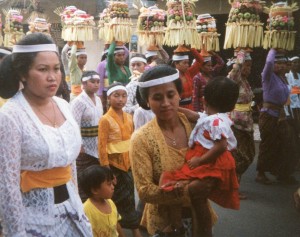Balinese have traditionally conducted a ceremony to straighten out the world. A long procession winds to the sea, where people leave offerings.
They believe that this calms the forces under the land, which they imagine as a giant turtle that causes earthquakes when he fidgets.
I leaned against a building on the main street of a small town and savored the colors as the procession passed. Women in white gowns balanced bamboo baskets of flowers, banana leaves and fruit on their heads. Men paraded in bright silk shirts. Teams carried gleaming bronze gongs on poles.
The feast of hues blended in a flow that was both lively and relaxed. It was all so pretty that the unseen forces that can enrich or harm a community must have enjoyed it too.
If you’re strictly modern you might look down on this way of thinking. Don’t animism and rituals for spirits and metaphysical power represent a primitive mentality?
This is a good question from a modern Western perspective. But Southeast Asia has its own logic–its own assumptions about how the world hangs together, and about the mental associations that promote the most security and happiness. These rituals are often performed with beauty that defies ways Westerners define things.
Flowers, sumptuous art and crafts, lively music, aromatic food and elegant clothing mix in a stream of grace and tolerance that’s as good an ideal as Platonic abstractions.
Many Southeast Asians have considered their abundance of rituals hallmarks of civilization. Lots of Western travelers have admired their high standards of politeness and cleanliness. The artistry and frequency of rites remind folks that they live in an integrated society and that social obligations are precious.
They also foster a lot of fun. People dress up, crack jokes, gossip, eat great food and watch unforgettable pageantry.
Westerners are used to admiring static art forms, like Greek sculpture and Italian paintings. But this art is in motion, and it incorporates all of Southeast Asia’s immense variety of life forms. They blend in a dance that’s tolerant and fun. This is as far from being primitive as you can get.



Comments on this entry are closed.